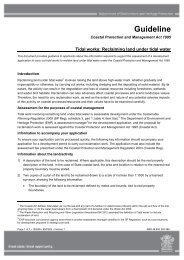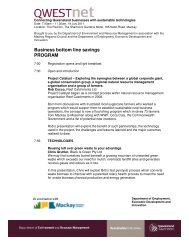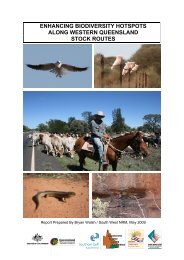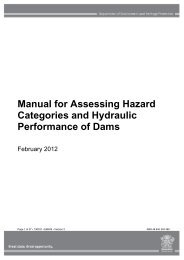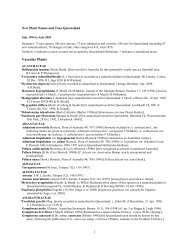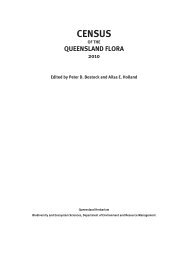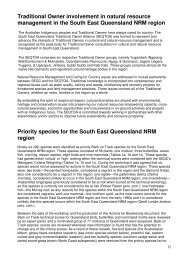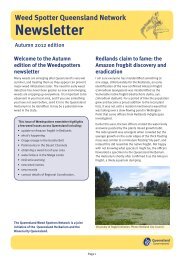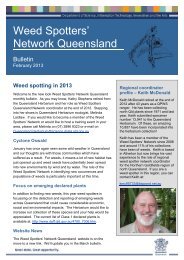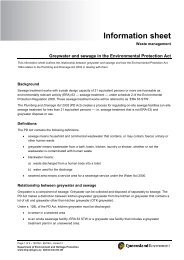Distribution, abundance and biology of Group V humpback whales ...
Distribution, abundance and biology of Group V humpback whales ...
Distribution, abundance and biology of Group V humpback whales ...
You also want an ePaper? Increase the reach of your titles
YUMPU automatically turns print PDFs into web optimized ePapers that Google loves.
6.1.2 Sloughed skin sampling<br />
Sloughed skin sampling is a technique used for collecting<br />
genetic material from samples such as skin, hair <strong>and</strong> faeces<br />
from an individual at the surface (Palsbøll 1997). Sloughed<br />
whale skin contains enough DNA for genetic analysis,<br />
<strong>and</strong> <strong>of</strong>fers a non-intrusive method for collecting tissue<br />
(Valsecchi et al.1998). A study undertaken by Valsecchi<br />
(1998) demonstrated that sloughed skin sampling is a viable<br />
alternative to genetic sampling <strong>and</strong> is particularly effective<br />
when applied to active groups. The sloughed skin sampling<br />
technique <strong>of</strong>fers a viable alternative to biopsy darting in<br />
regions where darting is either not permitted or otherwise<br />
undesirable.<br />
Amos <strong>and</strong> Hoelzel (1992) described a method for preserving<br />
skin tissue for DNA-based analysis. The collection <strong>of</strong> skin<br />
tissue for genetic analysis is preferable because skin is<br />
easily accessible <strong>and</strong> is rich in DNA. Skin from str<strong>and</strong>ed<br />
<strong>whales</strong> can remain usable for at least a week, <strong>and</strong> probably<br />
longer depending upon ambient conditions (Amos <strong>and</strong><br />
Hoelzel 1992).<br />
6.1.3 Acoustic tracking<br />
Male <strong>humpback</strong>s sing while migrating to <strong>and</strong> from their<br />
wintering grounds <strong>and</strong> while they are present at the<br />
wintering grounds. However, it is uncertain whether or<br />
not song functions to maintain a space between pods or<br />
to attract females (Tyack 1981). All males in a population<br />
produce the same song, which changes over time <strong>and</strong> with<br />
increasing distance (Cato 1991).<br />
Noad et al.(1998) undertook an acoustic <strong>and</strong> visual tracking<br />
study in south-east Queensl<strong>and</strong> <strong>and</strong> concluded that acoustic<br />
tracking may be especially useful for the study or survey<br />
<strong>of</strong> whale movements beyond visual range <strong>of</strong> shore-based<br />
observation points. The information gathered is dependent<br />
upon the number <strong>of</strong> hydrophones used. Three hydrophones<br />
provided positional information on singing <strong>humpback</strong>s <strong>and</strong><br />
the paths they took. Three hydrophones are required to<br />
make a direct comparison between visual <strong>and</strong> acoustic<br />
tracking methods. The study has implications for the<br />
interactions between singers <strong>and</strong> non-singing <strong>humpback</strong>s;<br />
interactions between individual singers; migratory behaviour<br />
<strong>and</strong> travel rates; pod composition; habitat use; song function<br />
<strong>and</strong> boat-whale interactions. Although acoustic tracking<br />
gathers information from singing individuals, it cannot be<br />
used as a technique to identify individuals for long-term<br />
studies.<br />
For other innovations in monitoring <strong>humpback</strong>s out <strong>of</strong> visible<br />
range <strong>of</strong> ships, acoustics have been used with other species<br />
<strong>and</strong> may eventually prove feasible for monitoring <strong>humpback</strong><br />
occurrence at remote areas such as outer reef complexes<br />
(Clark et al.1996 <strong>and</strong> 2002; Clark <strong>and</strong> Fristup 1997;<br />
Clark <strong>and</strong> Ellison 2000; Frankel et al.1995).<br />
6.2 Manipulative sampling techniques<br />
A close approach to a whale is required for the attachment<br />
<strong>of</strong> a conventional tag, the taking <strong>of</strong> samples for genetic<br />
analysis <strong>and</strong> the taking <strong>of</strong> identifying photographs. The<br />
attachment <strong>of</strong> tags <strong>and</strong> biopsy sampling are considered<br />
as manipulative research (Queensl<strong>and</strong> Department<br />
<strong>of</strong> Environment 1997). However, the certainty with<br />
which a sample is taken <strong>and</strong> the information provided<br />
is considerable, especially when combined with photoidentifi<br />
cation data.<br />
In general biopsy samples have not been taken from calves<br />
due to cultural sensitivities <strong>and</strong> the perceived impacts <strong>of</strong><br />
the technique. In 1992, a study undertaken by Valsecchi<br />
et al.(2002) targeted mother <strong>and</strong> calves pairs for genetic<br />
analysis;<br />
biopsy samples were taken from the mothers <strong>and</strong> when<br />
conditions were favourable sloughed skin samples were<br />
taken from the accompanying calf. The study supports the<br />
notion that mothers travel with their <strong>of</strong>fspring for the fi rst<br />
year <strong>of</strong> the calf’s life.<br />
6.2.1 “Discovery tags”<br />
Chittleborough (1959a) <strong>and</strong> Dawbin (1959) used “discovery<br />
tags” to provide distributional information on the group IV<br />
<strong>and</strong> V populations during the commercial whaling period.<br />
Discovery tags were conventional metal tags inserted<br />
sub-dermally into the <strong>humpback</strong>. The tags were retrieved<br />
when the harvested whale carcass was processed. The<br />
discovery tags were successfully used to reveal that some<br />
intermingling was occurring on the feeding grounds between<br />
the group IV <strong>and</strong> V populations; <strong>and</strong> the migratory routes,<br />
either side <strong>of</strong> the Australian continent, to the wintering<br />
grounds <strong>of</strong> the group IV <strong>and</strong> V populations<br />
(Chittleborough 1965).<br />
6.3 Biopsy sampling<br />
Biopsy sampling is a technique that involves the taking<br />
<strong>of</strong> a core <strong>of</strong> skin using a dart fi red from a crossbow. The<br />
biopsy dart is a cylindrical punch measuring approximately<br />
10mm in diameter <strong>and</strong> 30mm long. A metal fl ange at the<br />
base controls the depth <strong>of</strong> penetration by the dart. The<br />
dart has a collar <strong>of</strong> fl otation behind the tip, <strong>and</strong> may or<br />
may not be tethered to assist retrieval (Brown et al.1994).<br />
The combination <strong>of</strong> genetic <strong>and</strong> photo-identifi cation data<br />
provides a powerful tool for identifying individual <strong>humpback</strong>s<br />
(Stevick et al.2001).<br />
The reactions <strong>of</strong> several cetacean species to biopsy<br />
sampling have been investigated (Patenaude <strong>and</strong> White<br />
1995; Gauthier <strong>and</strong> Sears 1999; Weinrich et al.1992).<br />
Clapham <strong>and</strong> Mattila 1993b <strong>and</strong> Brown et al.(1994)<br />
undertook studies on <strong>humpback</strong>s <strong>and</strong> concluded there<br />
was no signifi cant change in behaviour to the biopsy<br />
sampling. However, Weinrich et al.(1992) <strong>and</strong> other authors<br />
have noted that there is a greater reaction to the human<br />
disturbance caused by the boat <strong>and</strong> its occupants than to<br />
the sampling technique itself.<br />
Brown et al.(1994) investigated the behavioural responses<br />
<strong>of</strong> east Australian <strong>humpback</strong>s to biopsy sampling <strong>and</strong><br />
suggests that female <strong>humpback</strong> <strong>whales</strong> maybe particularly<br />
responsive to human disturbances. They concluded that<br />
biopsy sampling has minimal impact on <strong>humpback</strong>s.<br />
Hooker et al.(2001) compared the reactions <strong>of</strong> biopsy<br />
sampling with tag attachment on northern bottlenose<br />
<strong>whales</strong> Hyperoodon ampullatus. They found the reactions<br />
<strong>of</strong> various species to biopsy darting is generally mild, the<br />
most common response is a “startle” reaction, although<br />
the level <strong>of</strong> reaction varies slightly between species, <strong>and</strong><br />
also between populations <strong>and</strong> individuals. In contrast, the<br />
reaction <strong>of</strong> cetaceans to tagging with suction-cups-attached<br />
tags has been found to vary dramatically.<br />
Biopsy sampling is described as a manipulative research<br />
technique. The technique is neither encouraged nor<br />
excluded by the management approach adopted in<br />
Queensl<strong>and</strong>.<br />
6.4 Telemetry<br />
Telemetry tags methods include the use <strong>of</strong> satellite-linked<br />
time-depth recorders, satellite-linked position beacons,<br />
time-depth recorders <strong>and</strong> VHF radio tags. This technique is<br />
a powerful took for investigating aspects <strong>of</strong> baleen <strong>whales</strong>’<br />
ranging behaviour, <strong>and</strong> are likely to become a powerful tool<br />
in the future. Mate et al.(1997, 1999 <strong>and</strong> 2000) illustrates<br />
the use <strong>and</strong> application <strong>of</strong> the tagging techniques on other<br />
baleen species.<br />
12 • <strong>Distribution</strong>, <strong>abundance</strong> <strong>and</strong> <strong>biology</strong> <strong>of</strong> <strong>Group</strong> V <strong>humpback</strong> <strong>whales</strong> Megaptera novaeangliae: A review • August 2002



